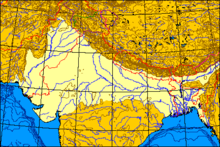Punjab Plain
This article needs additional citations for verification. (May 2017) |

The Punjab Plain is a large alluvial plain in Eastern Pakistan and Northwestern India. The plain includes the Pakistani province of Punjab and the Indian states of Punjab and Haryana, and parts of Rajasthan. This plain is around 200–300 meters above mean sea level. The plain is extensively farmed for cereals and cotton.[1]
The plain is the western part of the Indo-Gangetic Plain, which is formed by the Indus River and its tributaries - the Jhelum, the Chenab, the Ravi, the Beas and the Sutlej.
The land formed of alluvium in between two rivers known as Doab is found here.
'Doab' is made up of two words — 'do' meaning two and 'ab' meaning water. Similarly 'Punjab', is also made up of two words — 'Punj' meaning five and 'ab' meaning water.
Bhangar : The flood plains formed due to deposition of older alluvium is known as Bhangar.
Bet : The flood plains seen here which are formed due to repeated deposition of new alluvium during each flood is known as Bet. The plains are in the plain biomes.
References
- ^ "Punjab Plain | plain, India". Encyclopedia Britannica. Retrieved 13 April 2017.
